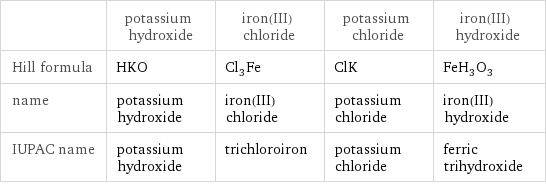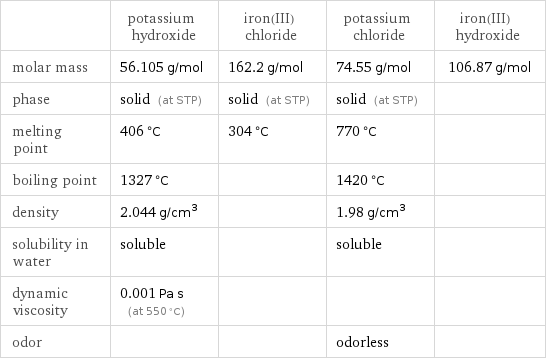Input interpretation

potassium hydroxide + iron(III) chloride ⟶ potassium chloride + iron(III) hydroxide
Balanced equation

Balance the chemical equation algebraically: + ⟶ + Add stoichiometric coefficients, c_i, to the reactants and products: c_1 + c_2 ⟶ c_3 + c_4 Set the number of atoms in the reactants equal to the number of atoms in the products for H, K, O, Cl and Fe: H: | c_1 = 3 c_4 K: | c_1 = c_3 O: | c_1 = 3 c_4 Cl: | 3 c_2 = c_3 Fe: | c_2 = c_4 Since the coefficients are relative quantities and underdetermined, choose a coefficient to set arbitrarily. To keep the coefficients small, the arbitrary value is ordinarily one. For instance, set c_2 = 1 and solve the system of equations for the remaining coefficients: c_1 = 3 c_2 = 1 c_3 = 3 c_4 = 1 Substitute the coefficients into the chemical reaction to obtain the balanced equation: Answer: | | 3 + ⟶ 3 +
Structures

+ ⟶ +
Names

potassium hydroxide + iron(III) chloride ⟶ potassium chloride + iron(III) hydroxide
Chemical names and formulas

| potassium hydroxide | iron(III) chloride | potassium chloride | iron(III) hydroxide Hill formula | HKO | Cl_3Fe | ClK | FeH_3O_3 name | potassium hydroxide | iron(III) chloride | potassium chloride | iron(III) hydroxide IUPAC name | potassium hydroxide | trichloroiron | potassium chloride | ferric trihydroxide
Substance properties

| potassium hydroxide | iron(III) chloride | potassium chloride | iron(III) hydroxide molar mass | 56.105 g/mol | 162.2 g/mol | 74.55 g/mol | 106.87 g/mol phase | solid (at STP) | solid (at STP) | solid (at STP) | melting point | 406 °C | 304 °C | 770 °C | boiling point | 1327 °C | | 1420 °C | density | 2.044 g/cm^3 | | 1.98 g/cm^3 | solubility in water | soluble | | soluble | dynamic viscosity | 0.001 Pa s (at 550 °C) | | | odor | | | odorless |
Units
